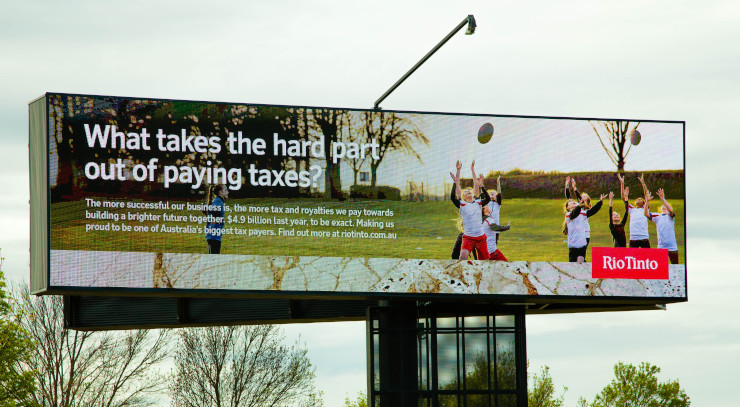IAN McAULEY. Outdoor advertising enclosing the commons
October 9, 2018
The furore over the projection of horse racing on the Sydney Opera House raises not only the issue of the treatment of Louise Herron at the hand of a radio shock jock and her lack of support from the NSW Government, but also the broader issue of appropriation of public space for commercial purposes.
The NSW Premiers decision to allow advertising for a horse race to be projected on to the Sydney Opera House involves two issues.
One is the way Opera House CEO Louise Herron was treated in an on-air phone callfrom Alan Jones and Peter VLandys of Racing NSW, a call Michelle Grattandescribed as laden with denigration, abuse and threats. It included Joness statement:
I will be speaking to [Premier] Gladys Berejiklian in about five to three minutes and if you cant come to the party Louise you should lose your job.
He has now apologizedfor his use of such language, but as Tim Costello points out in Pearls and Irritations, the incident illustrates once again the political power of the gambling industry in NSW.
The other issue concerns outdoor advertising in general be it for horse racing, banks, fast food chains or any other industry. Prime Minister Morrison put it plainly when he described the Opera House as the biggest billboard in the city, and suggested that the Sydney Harbour Bridge should also be used for advertising. Anyone opposed to such advertising he described as precious.
If that is so, it would appear that more than a quarter of a million Australians who signed Mike Woodcocks change.orgpetition are people of delicate sensibilities.
But public anger is about far more than aesthetics or good taste as the Premier puts it. Rather, much of that concern is about the appropriation of our public assets and our public space for commercial purposes. As my colleague Miriam Lyons points out, its about present-day enclosure of the commons.
Seventy-five years ago in his book The Great Transformation the Hungarian political philosopher Karl Polanyi warned about a social transformation where markets, which historically had been subject to societys norms and rules, would come to dominate society. We would no longer be living in a society with markets bound in time and space (for example with limited shopping hours and defined commercial precincts), but we would be living in a market society.
As in Orwells _Nineteen Eighty-Four_written a few years later, there would be no such thing as private or common space. Just as Big Brother dominated all space in Orwells dystopia, so the market would dominate all space in the world Polanyi saw emerging.
In Polanyis time commercial radio and television were just making their inroads into peoples homes. A little later the first commercial shopping malls were established: these were spaces we entered with the permission of Westfield or Stockland Property, rather than as free citizens using our publicly-owned sidewalks and parks. Similarly, billboards on our highways and advertising in our public transport have become more commonplace.
Now we are seeing more electronic advertising projections such as in the Opera House proposal and strongly backlit changing displays on freeway overpasses, in pedestrian precincts, air terminals and railway stations. Drivers on Sydneys freeways can see several places where trees have been cleared to give better sightlines of electronic billboards.
As Ogden Nash said I think that I shall never see, a billboard lovely as a tree, indeed unless the billboards fall, I shall never see a tree at all.
For a graphic description of the brave new world of commercialized space, I commend JCDecauxs Trends in Out of Homeadvertising. (Warning frequently-changing bright images on that website may cause fatigue and stress.) Note the references to captive consumer audiences and to reaching the entire urban population there is to be no choice, no escape. Just in the last two years 1400 digital billboardshave been erected in Australia.
Unsurprisingly its becoming harder to find spaces free of outdoor advertising. But, just as in _Nineteen Eighty-Four_senior party officials were able to turn off the otherwise ubiquitous telescreen, so too can those with means and connections insulate themselves. You dont find billboards along the streets of Point Piper, Toorak or Unley Park. The first class lounges at our airports are as free of advertisements as a Trappist monastery: the billboards in the airline terminals are for the economy-class passengers.
Another refuge from outdoor advertising has been Canberra, but the last two years have seen an aggressive push by the Outdoor Media Associationto allow billboards in the ACT, and initially the Territory Government seemed to be amenable to their approach, on the basis of the Associations claims that outdoor advertising would enliven the national capital and provide it with vibrancy and amenity.
Just as the Opera House proposal has generated a strong response, so too did the proposal for billboards in Canberra. A Legislative Assembly inquiry generated hundreds of submissions, only two of which were in favour of outdoor advertising. In a citizen-funded survey, 69 percent of respondents agreed that outdoor advertising reduces the quality of outdoor space. Most respondents agreed that outdoor advertising in Canberra undermines our sense of community, only 22 per cent agreed that outdoor advertising has the potential to enliven our urban areas, and a whopping 78 percent agreed that the advertising-free environment of Canberra makes it more pleasant to live in than other bigger cities.
In other words the claims of the Outdoor Media Association are bunkum. People dislike outdoor advertising.
Perhaps some peoples dislike is on aesthetic grounds, and others are sensitive to the annoyance and distraction of a=outdoor advertising: there is already enough stress in commuting, by car or public transport, without the added assault of advertising. But both the Opera House case and the Canberra reaction point to a deeper resentment a reaction against the commandeering of public space for commercial purposes: we want to live in a society, not a 24/7 ubiquitous market. In Canberra some compared it to the way vandals tag places to denote gang territory.
Public reaction hasnt stopped the outdoor advertisers: In Canberra the owners of the privatised airport did a deal with the Coalition Commonwealth Government, to have Canberras advertising ban lifted for their newly-acquired land. On the perimeter of Canberra Airport are massive digitised billboards, erected in contemptuous defiance of demonstrated community standards. And the ACT government has been lax in enforcing its own laws on billboard advertising, as this web pageshows.

Governments can become sucked in to outdoor advertising by the revenue it brings in by way of license fees. But it is not some free gift. The $1 billionspent each year on outdoor advertising has to be covered by prices of goods and services. Thats about $100 per household for the benefit of a visually polluted environment. Some types of advertising can provide useful information about new products and prices, but outdoor advertising is not informative: it is mainly in the form of brand-name reinforcement a zero-sum competition in a parasitic industry. The main beneficiaries are the advertising firms themselves; only a trickle goes through to governments for the occasional park bench or WiFi hot spot. Outdoor advertising is a lousy way to raise public revenue.
In some jurisdictions governments have taken the initiative to ban outdoor advertising, particularly in mainland Europe. Even in the US, renowned for business friendly regulation, billboards are banned in Hawaii, Alaska, Maine, and Vermont. Its not only wealthy places than can afford to forgo revenue from advertisers: in Sao Paulo in Brazil, all outdoor advertising is banned.
With elections looming federally and in our two largest states there are potential votes for any party that might propose to ban outdoor commercial advertising: the Opera House issue provides a great opportunity for aspiring politicians to take a stand. While Bill Shorten has stood up for those Australians who rightly say that the Opera House is not a billboard, the responses from the Coalition and from NSW Labor have been pathetic. What are they frightened of Alan Jones, the gambling lobby or the outdoor advertising industry?
Ian McAuley and his colleague Miriam Lyons cover the work of Karl Polanyi and the phenomenon of enclosure of the commons in their work Governomics: can we afford small government?
